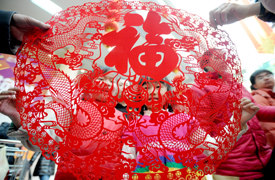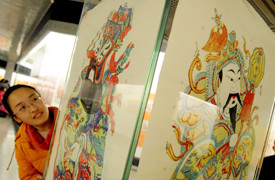|
 |
 |
|
RED BLESSING: A paper cutting work on the Chinese totem of dragon is displayed at a Spring Festival folk culture fair in Shenyang, Liaoning Province on January 25, 2012 (ZHANG WENKUI) |
ALL ABOUT DETAILS: A middle school student appreciates Chinese traditional New Year's painting works at an exhibition in Zhengzhou, Henan Province, on January 15, 2012 (ZHU XIANG) |
In addition to Shadow puppetry and Kunqu Opera, UNESCO has in total recognized 27 more items of living heritage in China by now. But they are only a small part of China's rich human treasures ranging from song, music, drama, skills to crafts.
To better preserve and pass on these treasures, China introduced a national project in 2005 to recognize and fund representative inheritors of folk crafts to pass them down from generation to generation.
Chen Xingcai, 93, is one of them. As one of the inheritors of Mianzhu New Year's painting craft, he has already passed the craft to his grandson, Chen Gang, and Chen Gang is teaching his five-year-old son to paint already.
Mianzhu in southwest China's Sichuan Province is one of the four famous manufacturers of New Year's paintings in China, along with Yangliuqing in Tianjin, Taohuawu in Suzhou, Jiangsu Province and Weifang in Shandong Province. It features bright colors and intricate hand painting, a style dating back to the Song Dynasty, which thrived in the Qing Dynasty (1644-1911) but fell to the wayside in recent decades. Young people have been reluctant to learn the skills required to master the handicraft. But the reconstruction after the 2008 Earthquake in Sichuan has saved the art form, which is protected as an intangible cultural heritage, from the brink of extinction.
Under a partnership plan which encourages cities nationwide to mobilize capital and labor to support the reconstruction in Sichuan, Suzhou spent more than 30 million yuan ($4.62 million) establishing a New Year's painting base in Nianhua Village. Now more than 90 percent of the villagers make a living on making New Year's paintings, as well as related businesses in the process. Jiangsu has also helped with sales of the paintings.
The Chen family is living in a government-funded quadrangle courtyard now, making an income of more than 100,000 yuan ($15,400) annually from the business.
Chen Yunlu, uncle of Chen Gang, started to learn the craft at the age of 10 and is now instructing young painters at the local museum.
"We can only keep such a traditional craft alive by infusing new content into it," Chen Yunlu told Beijing Review. "Although we are working around the clock to meet the orders, we think innovation either in content or form will secure us better market prospects."
The younger generation is able to take advantage of e-commerce. "We sell about 10,000 paintings every year, of which 10 percent are for online orders and this percentage is still increasing," said Chen Gang.
In addition to the inheritor system, the Chinese Government has also made efforts to protect the nation's cultural heritage through legislation.
After a decade's drafting, China's first law for intangible cultural heritage came into force on June 1, 2011. The legislation is expected to ensure better preservation of the country's cultural legacy.
"The primary target of China's heritage protection efforts used to be tangible items including artifacts and historic relics. The enactment of this new law means that for the first time Chinese traditional cultural practices now have legal protection," said Zhu Bing, an official from the Standing Committee of National People's Congress, China's top legislature.
The law is responsible for the traditional cultural expressions and practices of China's various ethnic groups, which have been handed down through generations.
It specifically covers traditional oral literature, performing arts, craftsmanship, medicine and folk customs.
Email us at: yuyan@bjreview.com | 